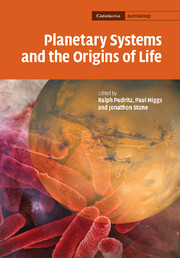Book contents
- Frontmatter
- Contents
- List of contributors
- Preface
- Part I Planetary systems and the origins of life
- Part II Life on Earth
- 6 Extremophiles: defining the envelope for the search for life in the universe
- 7 Hyperthermophilic life on Earth – and on Mars?
- 8 Phylogenomics: how far back in the past can we go?
- 9 Horizontal gene transfer, gene histories, and the root of the tree of life
- 10 Evolutionary innovation versus ecological incumbency
- 11 Gradual origin for the metazoans
- Part III Life in the Solar System?
- Index
6 - Extremophiles: defining the envelope for the search for life in the universe
Published online by Cambridge University Press: 13 August 2009
- Frontmatter
- Contents
- List of contributors
- Preface
- Part I Planetary systems and the origins of life
- Part II Life on Earth
- 6 Extremophiles: defining the envelope for the search for life in the universe
- 7 Hyperthermophilic life on Earth – and on Mars?
- 8 Phylogenomics: how far back in the past can we go?
- 9 Horizontal gene transfer, gene histories, and the root of the tree of life
- 10 Evolutionary innovation versus ecological incumbency
- 11 Gradual origin for the metazoans
- Part III Life in the Solar System?
- Index
Summary
Introduction
Of the three big questions astrobiology addresses, none has captured the public imagination as much as the question, ‘Are we alone?’ As knowledge increases about the physical environments available in the universe, organisms on the Earth are used to gauge the minimum envelope for life. Organisms that live on the physical and chemical (and perhaps, biological) boundaries are called ‘extremophiles’. Members of the domain Archaea are undoubtedly the high-temperature champions on Earth, surviving at temperatures far above the boiling point of water. However, a wide phylogenetic variety of organisms are able to inhabit other extremes, from low temperature to high salinity, from desiccation to high levels of radiation. In some cases, the adaptation is as simple as keeping ions out of the cell (low pH), but in others more profound adaptations are required. Reactive oxygen species are highly toxic, and thus organisms that are aerobic are arguably extremophilic. Thus, extraterrestrial habitats previously thought to be uninhabitable have been shown to be, at least theoretically, habitable, thus informing the search for life elsewhere.
Extremophilic organisms, or ‘extremophiles’, are integral to understanding the three big questions in astrobiology: Where do we come from? Where are we going? Are we alone? We do not know the environmental conditions under which life arose, although speculation includes hydrothermal areas; nor do we know the environments in which the earliest life forms existed.
- Type
- Chapter
- Information
- Planetary Systems and the Origins of Life , pp. 113 - 134Publisher: Cambridge University PressPrint publication year: 2007
- 7
- Cited by



